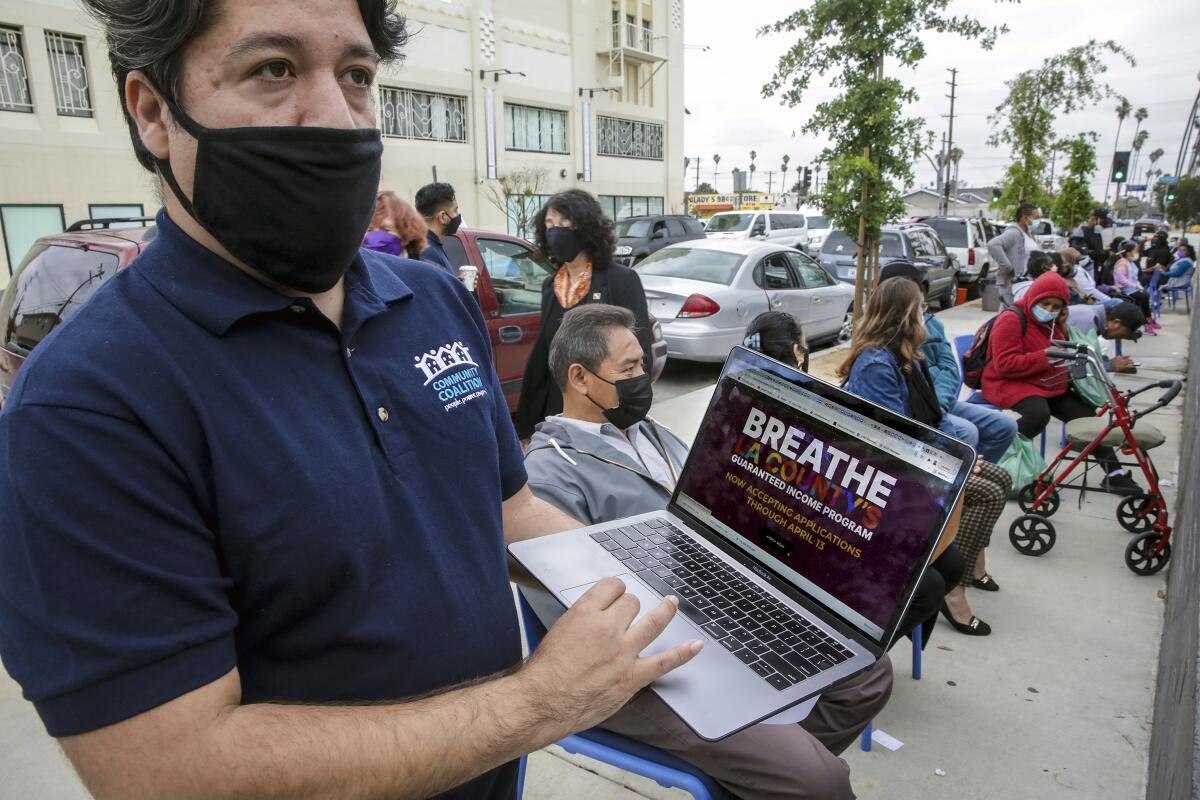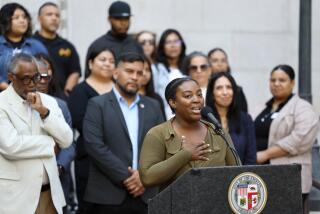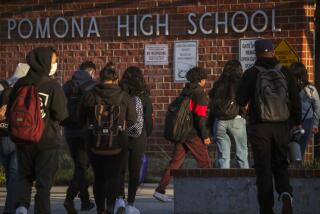L.A. County opens its $1,000-a-month aid program to former foster youth. Here’s how to apply

Kipp Kahlia spent several decades touring as a guitarist with reggae artists from Jamaica until illness forced her to put a halt to her career. She began offering private guitar and bass lessons as a stopgap solution, still envisioning herself writing and performing songs some day that championed social justice and fostered understanding and empathy among audiences.
Like many people shifting career gears, Kahlia had trouble making ends meet. She found crucial support, though, from Breathe, the L.A. County government’s guaranteed income pilot program.
Kahlia is one of 1,000 county residents who will receive $1,000 a month for 36 months from the program. And now the county is extending the aid to a new group: former foster youth.
Specifically, the program will offer $1,000 per month for two years to 200 young adults who were under the care of the L.A. County Department of Children and Family Services. This expansion is being carried out in collaboration with the nonprofit Strength-Based Community Change organization and the University of Pennsylvania’s Center for Guaranteed Income Research. Funding for Breathe comes from federal COVID-19 relief dollars.
The program will start accepting applications Tuesday, but those interested need to act fast; the application window closes in two weeks.
In addition to the 200 participants, the county will select a control group of 450 foster youth who will not receive cash assistance. Both groups will actively participate in research activities conducted by the Center for Guaranteed Income Research, such as surveys and interviews, to better understand participants’ experiences.
For their time, members of the control group will receive $50 gift cards for each survey completed after the application and initial round of questions.
Every year, approximately 4,000 foster youth in California who have reached adulthood leave foster care, making them ineligible for further placements and support.
“When you compare former foster youth to other cohorts of youth in the same situation as them, their rates of homelessness, unemployment, incarceration, and being involved in the justice system are higher,” said Carrie Miller, executive director of the county’s Poverty Alleviation Initiative.
This is especially true in Los Angeles County, which has the greatest number of foster care youths in California. In January 2017, almost one-third of young people in foster care between the ages of 16 and 21 were enrolled in aid programs for low-income youths.
Here are more details on the county’s program and the application process.
Who is eligible for the program?
You are eligible if you meet all of these requirements:
- You are between the ages of 21 and 23.
- You are a former L.A. County foster youth who was in foster care either on or after your 18th birthday, but have since have transitioned out of the system.
- You live in an L.A. County neighborhood that falls at or below 100% of the county’s median household income, which the state Department of Housing and Community Development says is $98,200 in 2023.
- If your household consists of a single person, your income must be equal to or less than 100% of the county’s area median income, which is $68,750 for a single individual in 2023, according to the state’s figures. Alternatively, if your household has two or more individuals, your income should be equal to or less than 120% of the county’s area median income.
- You have been negatively financially impacted by the COVID-19 pandemic. You do not have to show documentation to prove this.
- You are not currently enrolled in another guaranteed income program offered by the county, a city, or any other public or private entity globally.
- You are the only person in your household to participate in the program. If you file taxes with someone (such as your spouse or someone who claims you as a dependent), then you will not be eligible.
How can I apply for the guaranteed income program?
- Visit the Breathe website during the application period, which runs from June 20 at 6 am to 11:59 pm on July 3. That’s the only time the application will be accessible.
- Before you begin the application, you will need to go through an online screening to ensure that you meet the eligibility requirements. If you do, the full application survey link will appear after you complete the screening.
- The application includes a research survey that will take about 45 minutes to complete. The survey asks a series of questions about your overall health and well-being, including financial stability, physical and psychological health, support networks and economic and food security. Whatever your answers are, they won’t affect your chances of being accepted into the program.
If you need help applying:
- Call the Strength Based Community Change hotline, which is staffed Monday to Friday from 8 am to 8 pm and Saturday from 9 am to 1 pm, at (323) 736-2122. Alternatively, you can visit designated drop-in centers across the county or call the hotline for more information.
- If you have a disability and need assistance with the application, you can use accessibility software on your device, visit a drop-in center if possible, or call the hotline.
How will you know if you’re accepted?
Once you submit your application, Strength Based Community Change will be in touch to let you know whether you were selected. Miller said that participants are expected to be fully enrolled by the end of August.
The county will provide the cash grants to participants through a prepaid debit card, which will be topped up every month. Participants are not required to have a bank account and can withdraw money from various ATMs without incurring any service fees. Nor does the card charge usage fees.
What does the research show?
The Center for Guaranteed Income Research will survey participants every six months, concluding six months after the final cash grant. It will issue a final report on the program about a year later.
Allison Thompson, executive director of the Center for Guaranteed Income, said researchers will explore how the aid affects formerly foster youths’ well-being and self-determination, “and how it potentially frees them to engage differently in other domains of their lives, like education and employment choices, in order to give space and breathing room to be able to make those choices.”
Thompson said that there’s limited data about programs that offer youths direct cash assistance. The center’s goal is to show the effectiveness of such programs, use the findings to inform policy solutions, and develop a sustainable method for people to receive direct cash assistance.
For Breathe’s first year, the average age of participants was 40 and 57% of them identified as Hispanic. They spent the vast majority of their money on basic needs: a little more than a third of it went to food and groceries, a little less than a third to retail and services, and about a tenth to transportation. Less than 6 cents of every $1 went toward entertainment and miscellaneous expenses, the survey found.
Among other things, Kahlia said she has used her $1,000 monthly stipend to buy a new car to replace the 28-year-old one she’d nicknamed “Raggedy Andy,” create and maintain a new website, enroll in business classes, and fund other essential expenses.
“I asked how long the money would last for, thinking it was probably going to be a year, maybe six months,” said Kahlia. “When they told me three years, I nearly fell out of my chair and thought, that would give me time to do things properly.”
Participants work with economic development coaches who check in and offer guidance on financial management and achieving long-term stability.
What other resources do foster youth have in Southern California?
General resources for Los Angeles foster youth include:
- CASA of Los Angeles, which assigns trained volunteers to represent the interests of individual children in court and advocate for the child’s well-being and long-term stability. CASA also offers specific programs to assist youth ages 12 to 17 and dependents ages 18 to 21 who may be at risk of entering or re-entering the criminal justice or child welfare system.
- California Youth Connection, an advocacy group that offers foster care system-affected youth and young adults ages 14 to 24 the chance to push for improvements in foster care. Operating through regional chapters, including one serving Los Angeles, the organization trains members to advocate for changes to the law and public policy and to educate the public about the foster care system.
What other guaranteed income programs are in L.A. County?
- BIG:LEAP, which offered $1,000 per month for 12 months to about 3,200 Angelenos affected by poverty and COVID-19. Applications are closed but may open back up in the future.
- Compton Pledge, which offered cash grants of various sizes to more than 1,770 Compton residents, specifically formerly incarcerated, undocumented and low-income people.
- Long Beach Pledge, which offered $500 a month for a year to up to 250 single-adult families with children affected by the COVID-19 pandemic. Applications are closed but may open back up in the future.
- West Hollywood Pilot for Guaranteed Income, which offered $1,000 a month for 18 months to about 25 residents of West Hollywood who are over age 50. Applications are closed but may open back up in the future.
- TAYportunity, an employment program for transitional-aged youth who receive $1,000 per month and participate in workshops to improve their financial literacy. Applications are closed but may open back up in the future.
“What we’re seeing with guaranteed income programs is that the power of unconditional cash for those who receive it is tremendous — folks are more likely to want to go back to school, open their own business, and do other activities that help promote their own ability to support themselves and support their families,” said Miller. “This needs to become a permanent part of the way we deliver services.”
More to Read
Sign up for Essential California
The most important California stories and recommendations in your inbox every morning.
You may occasionally receive promotional content from the Los Angeles Times.











